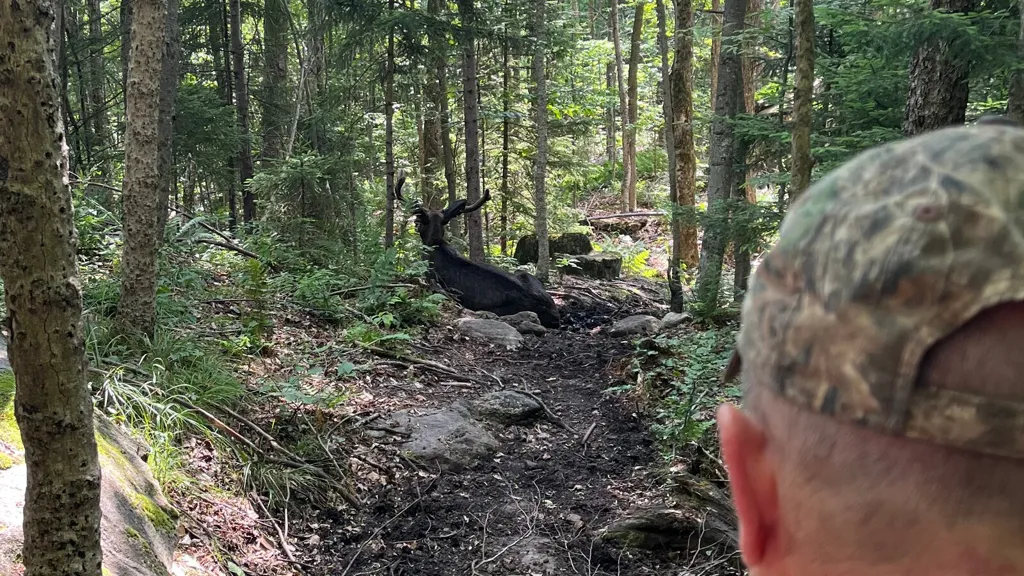Sickness, not stubbornness, is the most likely explanation for the animal's "unusual behaviors," which prompted the unusually long closure, officials said.
In early June, environmental conservation officials in New York closed a popular Adirondack Mountain trail after a bull moose was observed there over an extended period and did not appear interested in leaving.
On Monday, more than a month later, the moose was still there, and the Goodman Mountain trail was still closed as state wildlife experts sought to determine why the huge animal continued to linger.
The most likely explanation for its "unusual behaviors," the Department of Environmental Conservation said, was "an underlying illness" that was causing the moose to remain "not responsive to attempts to move it off" the trail.
"The trail will remain closed to protect the moose and ensure public safety in the event of a close encounter with the public," the department said in a news release on Friday. "Moose are large animals, and while no signs of aggression have been observed, moose can be dangerous if approached too closely."
The unusually long closure of the mile-and-a-half-long trail, in Horseshoe Lake Wild Forest near Tupper Lake, began on June 6. Then, with the moose continuing to ignore repeated efforts to shoo it away, environmental conservation staff members, including a wildlife veterinarian, visited the site on Thursday and decided the trail should stay off-limits.
Awesome to behold in the wild, moose are the largest members of the deer family and are among the largest land mammals in North America. The male, or bull, typically stands six feet tall at the shoulder, weighs up to 1,400 pounds and lives seven years on average.
Found in Alaska, Canada and the northern United States from North Dakota to northern New England, and from the northern Rocky Mountains to Utah, moose were once common in New York but disappeared in the 1860s primarily because of "habitat changes and unregulated hunting," according the Department of Environmental Conservation.
They began to return around 1980, drawn by habitat changes that made living conditions more favorable. Their typical home range is an area of five to 50 square miles.
The Adirondack Explorer news site reported that in 2018 there were an estimated 600 to 700 moose in the Adirondack region. Last fall, a state wildlife biologist told the Adirondack Park Agency that surveys showed there were about 716 moose in its jurisdiction. (By comparison, there are about 2,000 in Vermont and as many as 70,000 in Maine.)
"We haven't seen any evidence that it's going down, so it's at least stable,"
the biologist, Jim Stickles, said of the moose population, according to The Adirondack Explorer.
A primary threat to the species is illnesses caused by parasites like brain worm and especially giant liver fluke, a flatworm that in moose can cause liver failure and, ultimately, death.
Jen Grauer, a postdoctoral researcher at Cornell University's department of natural resources and the environment, studies parasitic threats to moose in the Adirondack Park. Without commenting on the Goodman Mountain moose, she said in an email that animals in the wild encounter various "parasites and pathogens that can influence their behavior and health."
Besides being hit by vehicles, Ms. Grauer said, "this seems to be the leading cause of death for moose." She cited a survival study monitoring moose that had been collared as calves which found that most of those that died had succumbed to giant liver fluke infections.
The Department of Environmental Conservation said that the site visit on Thursday had been meant to observe the moose's behavior and condition. Many diseases that affect moose are not detectable through blood work and are best identified by visual assessment, the agency noted.
The department plans to continue monitoring the moose with three trail cameras at the site. Staff members will make a follow-up visit if there are notable changes in the moose's behavior or if the animal is not seen on the cameras for "a period of time," according to the agency.
Goodman Mountain, which draws thousands of visitors a year, is named for Andrew Goodman, who, with fellow civil rights activists James Chaney and Michael Schwerner, was killed by Ku Klux Klan members in Mississippi in 1964. Growing up, Mr. Goodman, a Manhattan native, spent summers in the Tupper Lake area at a camp built by his grandfather.
